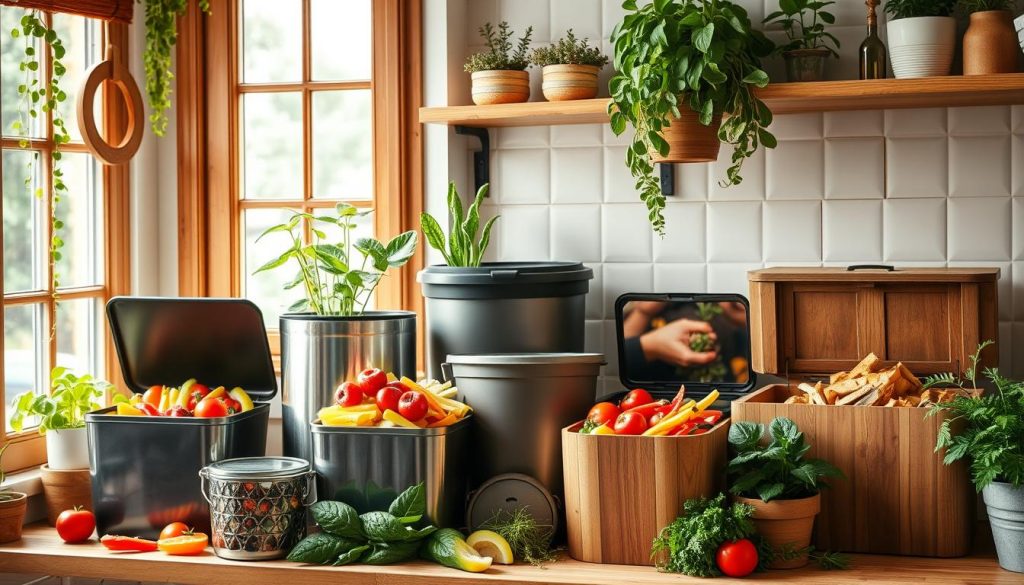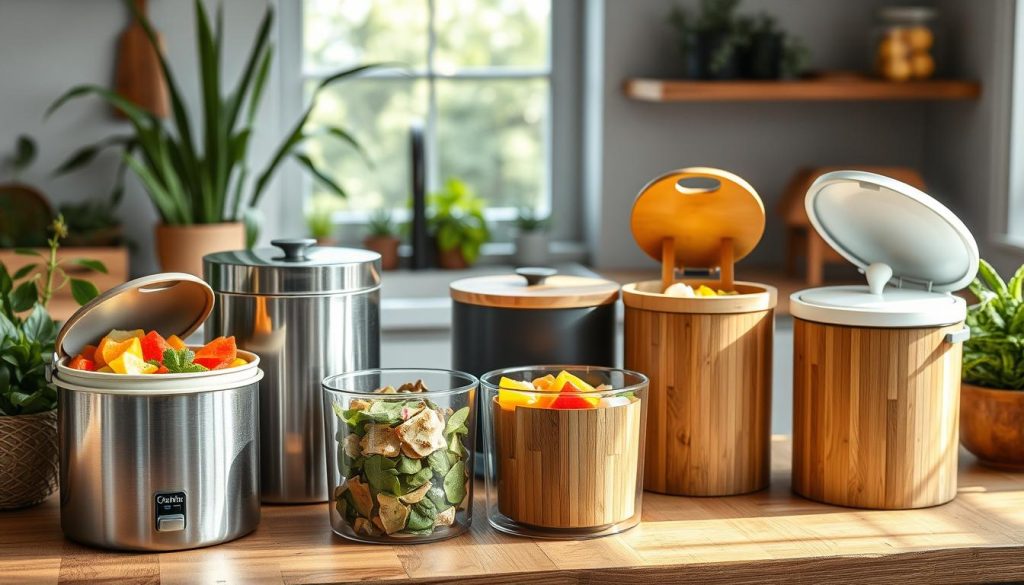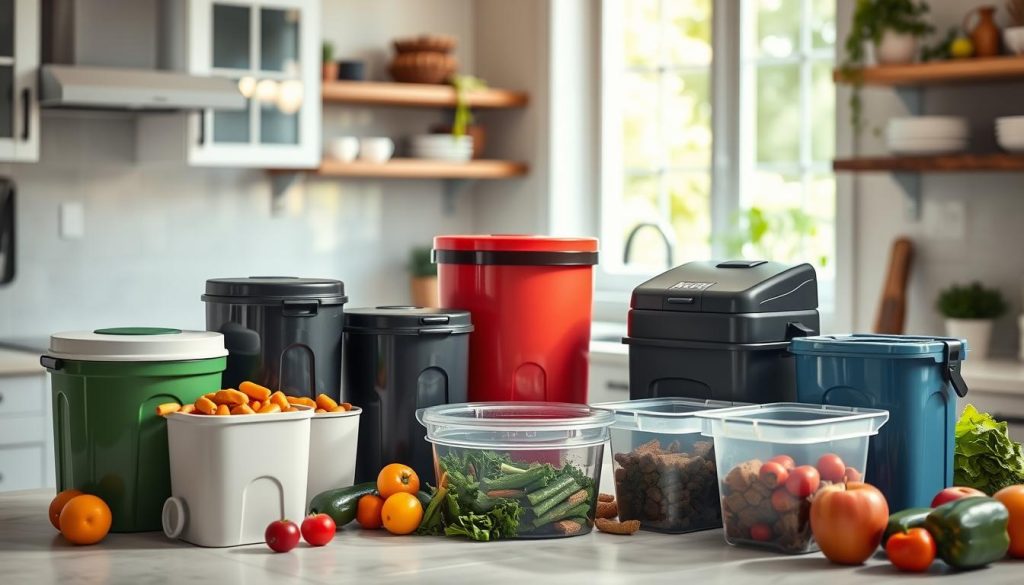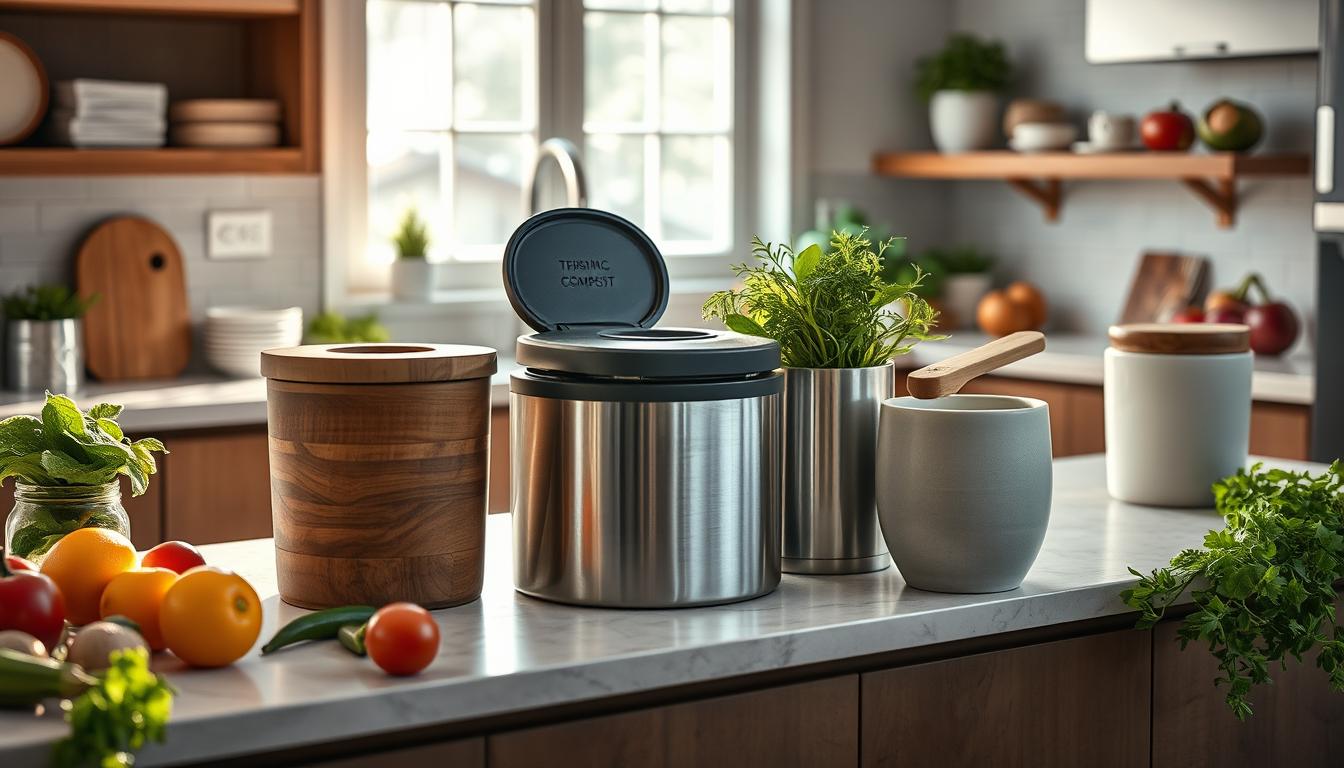I’m excited to share my knowledge on kitchen compost bins. They’ve become key to my sustainable kitchen. Using a compost bin for kitchen waste has greatly reduced my environmental impact. It also helps me make nutrient-rich soil for my garden.
Choosing the best kitchen compost bins can be tricky. There are many options, including indoor bins that match my kitchen decor.
I’ve looked into many types of compost bins. From small countertop models to big under-sink units. My aim is to find a balance between being useful, stylish, and eco-friendly.
Whether you need a simple bin for kitchen scraps or something more advanced, I’ll help you choose. I’ll guide you through picking the best kitchen compost bins for your needs.
Why I Compost: The Benefits of Kitchen Composting

Using kitchen compost bins has changed our household for the better. They help cut down on kitchen waste and turn food scraps into soil. With a compost pail or container, collecting and storing food waste is easy. This waste then becomes a valuable resource for our garden.
Some key benefits of kitchen composting are:
- Reducing the amount of waste sent to landfills
- Creating a natural fertilizer for my garden
- Helping to reduce my carbon footprint by decreasing the need for synthetic fertilizers
Using a compost caddy also makes composting easier. It’s placed in a spot where I see it often. This reminds me to add food scraps and other organic materials regularly. This keeps our compost pile healthy and productive, giving us plenty of nutrient-rich soil for our garden.
Types of Kitchen Compost Bins I Love
Choosing the right compost bin is key for successful kitchen composting. There are many types of bins, each with its own features and benefits. I’ve found several options that meet different needs and preferences.
Countertop compost bins are great for those who want easy access. They’re small and can sit on the counter, making it simple to add scraps. Stainless steel bins are also popular for their durability and easy cleaning. For those with little space, small bins are a good choice, offering a compact way to compost.
Countertop Bins: Convenience at My Fingertips
Countertop bins are perfect for daily use. They allow me to easily add food scraps and other organic materials. They come in various sizes to fit different kitchen countertops.
Under-Sink Bins: Space-Savers for My Kitchen
Under-sink bins are great for saving space. They fit under the sink and are easy to access when needed.
There are also electric composters and Bokashi bins. Electric composters use heat and microorganisms to break down food. Bokashi bins use fermentation to compost organic materials. When picking a bin, consider capacity, odor control, and material.
| Compost Bin Type | Features | Benefits |
|---|---|---|
| Countertop Compost Bin | Small size, easy to clean, made of stainless steel or plastic | Convenient, easy to use, perfect for daily composting |
| Under-Sink Compost Bin | Space-saving, easy to install, odor-controlled | Perfect for small kitchens, easy to access, reduces odors |
| Electric Composter | Uses heat and microorganisms, fast composting process | Efficient, easy to use, produces high-quality compost |
| Bokashi Bin | Uses fermentation process, compact size | Easy to use, produces high-quality compost, reduces odors |
Features to Consider in Kitchen Compost Bins

Choosing the right kitchen compost bins is important. They should hold the right amount of waste, control odors, and be durable. Let’s look at the key features to find the best compost caddy.
The size of my kitchen and how much waste I make matter. A big family might need a larger bin, while a single person might do with a smaller one.
Key Features to Consider
- Capacity: The size of the compost bin will depend on the amount of waste generated in my kitchen.
- Odor Control: A good compost caddy should have features that control odors, such as filters or odor-absorbing materials.
- Material: The material of the compost container should be durable, easy to clean, and sustainable.
By thinking about these features, I can pick a bin that fits my needs. Whether it’s a small caddy or a big container, the right features make a big difference.
My Top Picks: Best Kitchen Compost Bins

I’ve picked the best kitchen compost bins after lots of research and testing. These bins stand out for their special features and benefits. They’re perfect for both new and experienced composters.
I looked at things like size, smell control, and material when choosing. There’s a bin for every kitchen, from small to large. Here are my top picks for kitchen compost bins:
Review of Model A: Pros and Cons
Model A is a favorite among composters. It’s small and controls smells well. It’s also made to last and holds a lot, great for big families or lots of composting.
Review of Model B: Versatility in Use
Model B is great because it can handle many types of waste. It’s also easy to clean, perfect for beginners.
Review of Model C: Budget-Friendly Option
Model C is a budget-friendly choice. It’s small and simple, but does the job well. It’s a good start for those new to composting.
Think about what you need when picking a kitchen compost bin. Do you need something small or big? Look for features like smell control, durability, and ease of use. These top picks will help you find the right bin for your kitchen.
Choosing a top-rated kitchen compost bin helps reduce waste and makes soil. It’s a step towards a greener future. Happy composting!
Tips for Maintaining My Kitchen Compost Bin
Keeping a kitchen compost bin healthy is crucial for its benefits. Knowing what to compost and solving common problems are key. These tips will help me keep my indoor compost bin in top shape.
Composting 101: What to Add
Adding the right mix of materials is essential for a balanced compost pail. Fruit and veggie scraps, eggshells, coffee grounds, and shredded paper or cardboard are great. But, I’ll avoid meat, dairy, and oily foods to prevent pests and bad smells.
Troubleshooting Tips: Controlling Smells and Pests
If my kitchen compost bins smell, I’ll check the moisture. Adding dry materials like shredded newspaper or leaves helps. Keeping it covered and aerated also cuts down on odors. For pests, a bit of baking soda or vinegar solution works wonders.
Cultivating Compost: Rotation and Aeration
Regularly stirring or rotating my compost pail ensures even breakdown. I’ll also poke holes for airflow. With care, my kitchen compost bin will enrich my garden.

